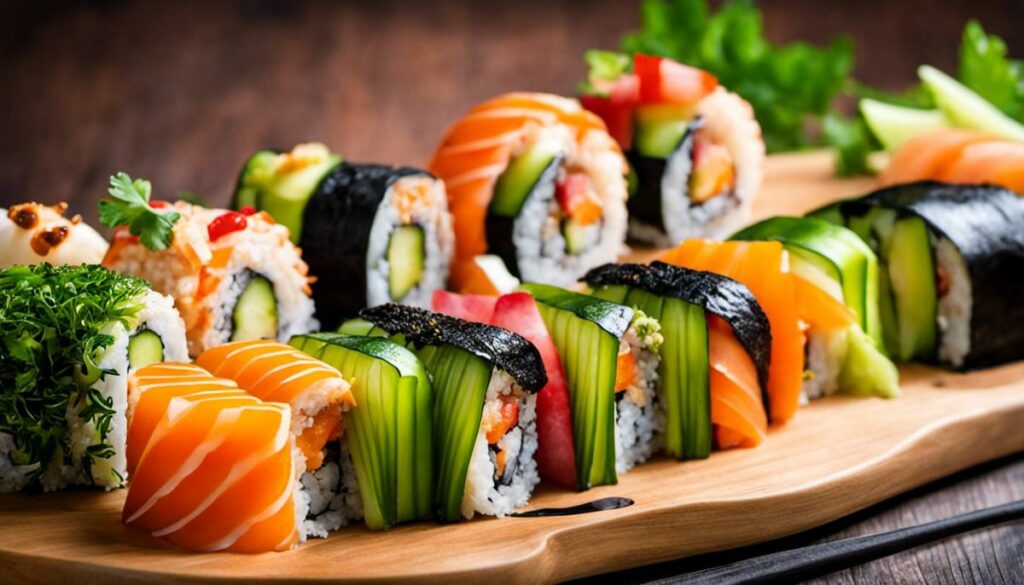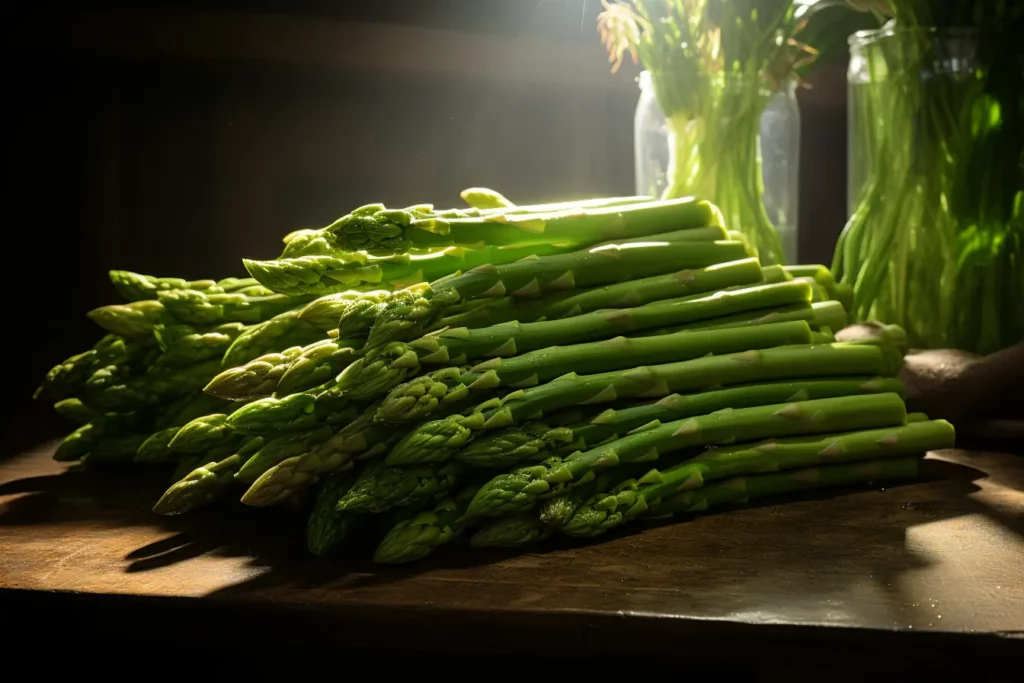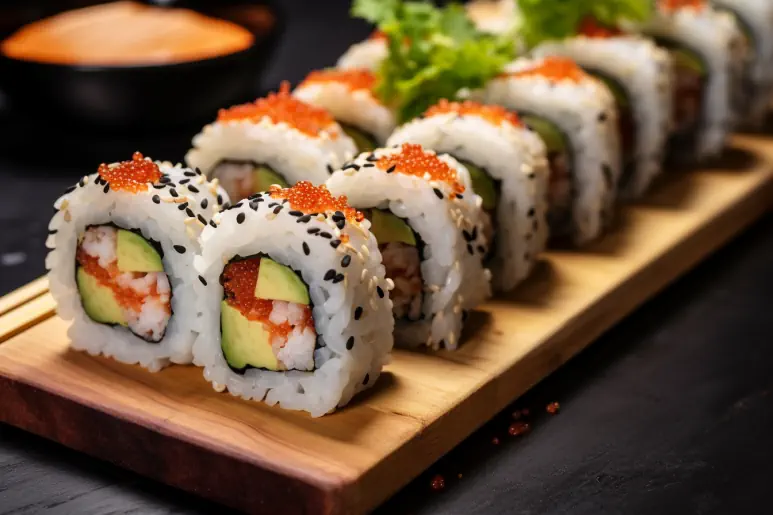Vegetarian sushi is an emerging art form in the culinary world. It goes far beyond the simple variants that contain only vegetables and rice, and stands out by introducing exciting, reimagined ingredients. With a plethora of colorful vegetable options and creative garnishes, these sushi pieces not only satisfy cravings for a tasty meal, but also offer a visual spectacle. From traditional vegan maki rolls to innovative creations with revolutionary flavor combinations, the world of vegetarian sushi shows us that the creative possibilities are almost limitless.
Types of Vegetarian Sushi
Title: Discover The Art of Vegetarian Sushi: A Fascinating Guide
In a world full of culinary possibilities, the freshness and sophistication of Japanese cuisine still reigns. Sushi, the tasty delicacy from the “Rising Sun”, has long since conquered palates worldwide. But what about those who want to eat vegetarian? Don’t worry! The world of sushi has a wide variety of options to suit all tastes, and the vegetarian section is no exception.
Let’s start with the classic vegetarian sushi one-bites. In addition to traditional variants with rice and vegetables, there are numerous vegan creations that focus on exotic superfoods and raw organic vegetables served with a hint of wasabi or ginger sauce.
Some of the most well-known vegetarian sushi types include:
- Maki sushi, the small vegetarian rolls with nori leaves, are filled with a variety of vegetables – from juicy cucumber pieces to sweet pumpkin and crunchy beetroot. Equally popular is the Inari sushi, which consists of rice marinated in sweet soy sauce and hidden in bags made of tofu skin – a true dream for all vegetarian sushi lovers.
- Temaki sushi offers a more festive option – the open cone shape is ideal for showcasing creative fillings such as pickled radish, asparagus or grilled peppers. Another well-known type is the nigiri sushi, which is traditionally served with fish, but is also offered in an exciting way with avocado, roasted red peppers or even marinated shiitake mushroom.
- For example, the Uramaki or Inside-Out reels, where the rice outside surrounds the nori, are bursting with creativity and are the perfect playground for a variety of vibrant fillings and toppings. From avocado, mango and asparagus to grilled eggplant and sautéed shitake mushrooms, the options are endless.
When it comes to vegetarian sushi, imagination and personal preference are key. Experimenting and combining with the variety of vegetables and exotic superfoods offers endless possibilities for flavor enhancement. Sushi is not just a meal, but a philosophy of life in which respect for the ingredients and their careful treatment are essential. So, be creative, try new flavor combinations, and offer your guests a vegetarian sushi experience they won’t soon forget. Have a good time!
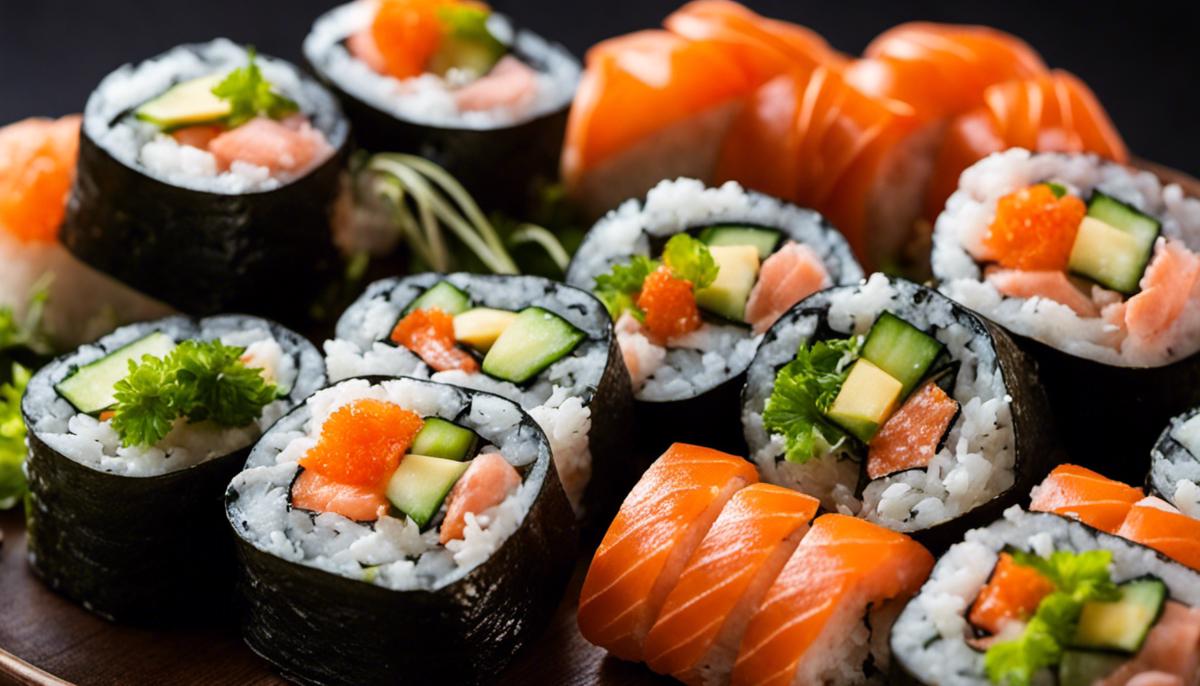
Ingredients in vegetarian sushi
The Art of Sushi: Elements and Components in Vegetarian Sushi
Vegetarian sushi may not necessarily be the first option that comes to mind when you think of sushi, but thanks to the wide range of flavors and ingredients, it has its own appeal. With an emphasis on seasonal and high-quality products, vegetarian sushi is an excellent choice for vegans, vegetarians and sushi lovers looking for alternative flavors.
First of all, it is important to understand the basis of each sushi roll: the perfectly cooked and seasoned rice. Traditionally, Japanese short-grain rice is used for sushi, which, after cooking, is refined with a mixture of rice vinegar, salt and sugar. This shiny and sticky rice is the centerpiece of any sushi roll and serves as a neutral carrier for the diverse flavor combinations in vegetarian sushi.
In addition to rice, kelp leaves, known as nori, are crucial to sushi preparation. They bring a maritime touch and provide the firm shell that holds the rice and fillings together.
In terms of fillings, vegetarian sushi brings an impressive variety to the table: from avocado, mango and beetroot to pickled carrots, grilled eggplant and shiitake mushrooms. These ingredients bring a colorful palette of flavors, textures, and colors that enchant any sushi experience.
Another important element in vegetarian sushi is the use of Japanese radish, known as daikon, which is often served as a side dish. Grated or cut into fine strips, it offers a refreshing and crisp note that balances perfectly with the other flavors.
Of course, no sushi dish would be complete without the right sauces and side dishes. Soy sauce, wasabi and pickled ginger are traditional accompaniments that are essential for both meat-based and vegetarian sushi. Its intense taste provides an explosion of the senses and rounds off the entire taste experience.
Finally, it’s worth taking a look at the presentation. As in many Japanese dishes, aesthetics play a crucial role in the sushi experience. Whether simply served on a plate or artfully presented in a bento box, vegetarian sushi is always a feast for the eyes.
The result is a culinary masterpiece that brings a touch of Japan directly to the plate. With so many options, it’s no wonder that vegetarian sushi resonates with sushi lovers and newcomers alike. It is truly a delight for the senses and proof that vegetarian does not lose any taste at all, but on the contrary opens up a new world of flavors.
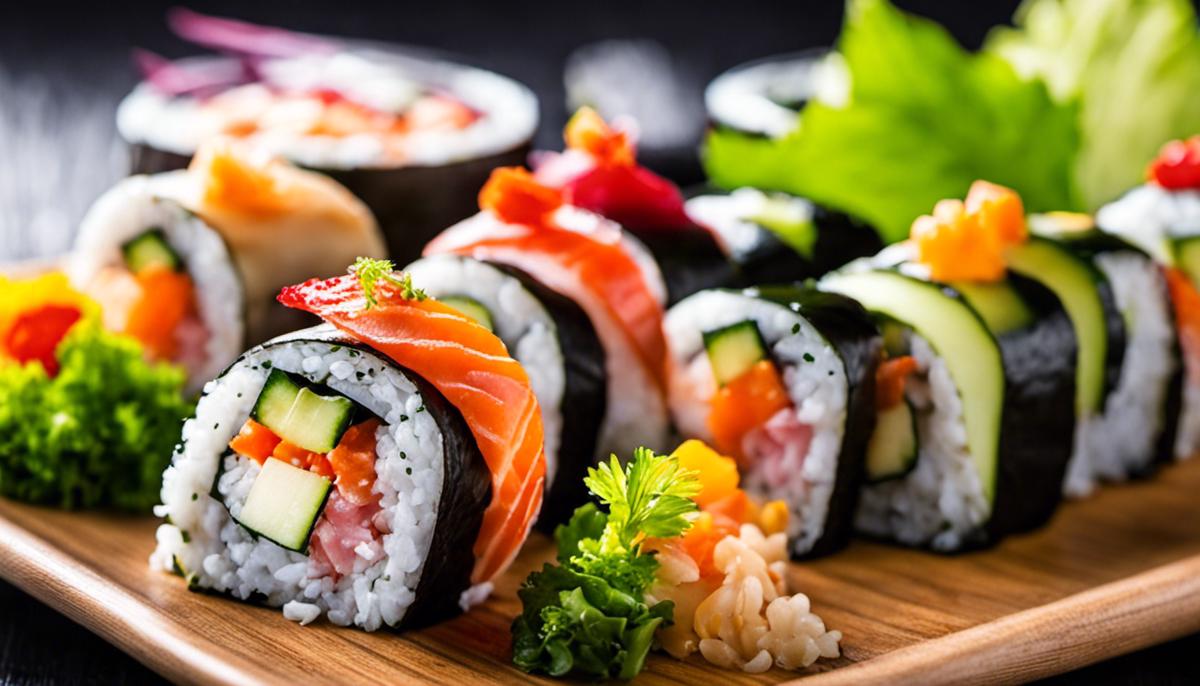
Preparation of vegetarian sushi
There is an art to making the perfect vegetarian sushi. After the intensive examination of the vegetarian sushi culture and the creativity that unfolds in the combination of the most diverse flavors, let’s dive further into sushi preparation.
First of all, the ideal choice of rice. A medium-grain sushi rice is the preferred choice, prepared with a drizzle of rice vinegar, sugar, and salt. It is important to wash and cook the rice properly – this is crucial for the final consistency and taste of the sushi.
The nori sheets, made from dried seaweed, act as a casing for the sushi rolls. These are rich in minerals and give sushi its distinctive taste. Therefore, the quality of the nori sheets is essential for excellent sushi.
The choice of vegetarian fillings knows no bounds. Whether it’s creamy avocado, sweet mango or crunchy beetroot, let your creativity run wild! An insider tip is the daikon radish, which is also enjoyed raw as a side dish. It adds a new dimension to the taste of sushi and also provides you with important vitamins and minerals.
When you think of sushi, you inevitably think of traditional sauces and side dishes – whether it’s the soy sauce with its savory taste, the spicy wasabi that provides that refreshing kick or the pickled ginger that prepares the palate for the next piece. Of course, these should not be missing from a real sushi experience.
Since sushi is an art form, presentation plays a crucial role. The aesthetics of the sushi, from the shape of the rolls to the enrichment with colors and textures of the fillings, add a visual dimension to the culinary experience.
After all, vegetarian sushi has captivated far more than just vegans and vegetarians. Even sushi lovers, who otherwise rely on fish, are enchanted by these meat-free works of art. The development of new worlds of taste and the exploration of the aesthetics of vegetarian sushi undoubtedly set new trends in the realm of gourmets.
So, what are you waiting for? Immerse yourself in the stunning world of vegetarian sushi and be amazed by the countless possibilities offered by this art form! Bon Appetit!
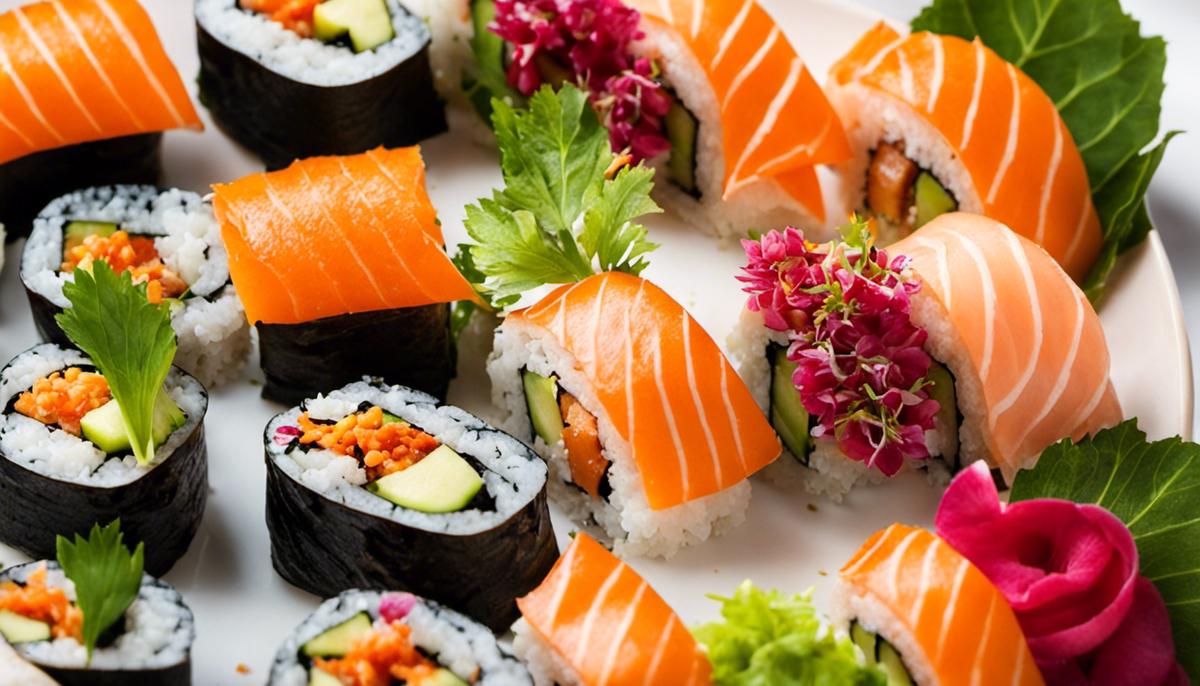
Health Benefits of Vegetarian Sushi
Vegetarian sushi is not only considered a trendy and culinary achievement, but also a boon for health. But what are the health benefits?
When it comes to sushi, many automatically think of fish. But vegetarian sushi focuses primarily on vegetables. Vegetables play an important role in our diet as they are rich in vitamins, minerals and antioxidants. It provides us with fibers that support our digestion and helps prevent diseases such as cardiovascular disease and cancer.
Rice is a main ingredient in sushi and a good source of carbohydrates. It promotes the feeling of satiety and provides long-lasting strength through its energy supply. The nori sheets used are rich in iodine, which is required for the production of thyroid hormones. These hormones regulate metabolism, body temperature, and more.
Vegetarian sushi can also help regulate blood sugar levels. Because it is a low-fat and low-sugar meal, as part of a balanced diet, it can help keep blood sugar levels under control.
It is also great for people who suffer from food allergies or intolerances. Since it contains a lot of vegetables and avoids meat and fish products, the chances of an allergic reaction are lower. Even if you are gluten intolerant, sushi can be an option, as long as you make sure that the rice you use does not contain gluten.
Finally, consuming vegetarian sushi helps reduce the environmental impact. The elimination of fish and other animal products reduces the need for resources such as water and land.
In conclusion, vegetarian sushi is not only a treat for the palate, but also for health. It allows you to enjoy a delicious meal and do something for your well-being at the same time. Give it a try and experience a new world of taste.
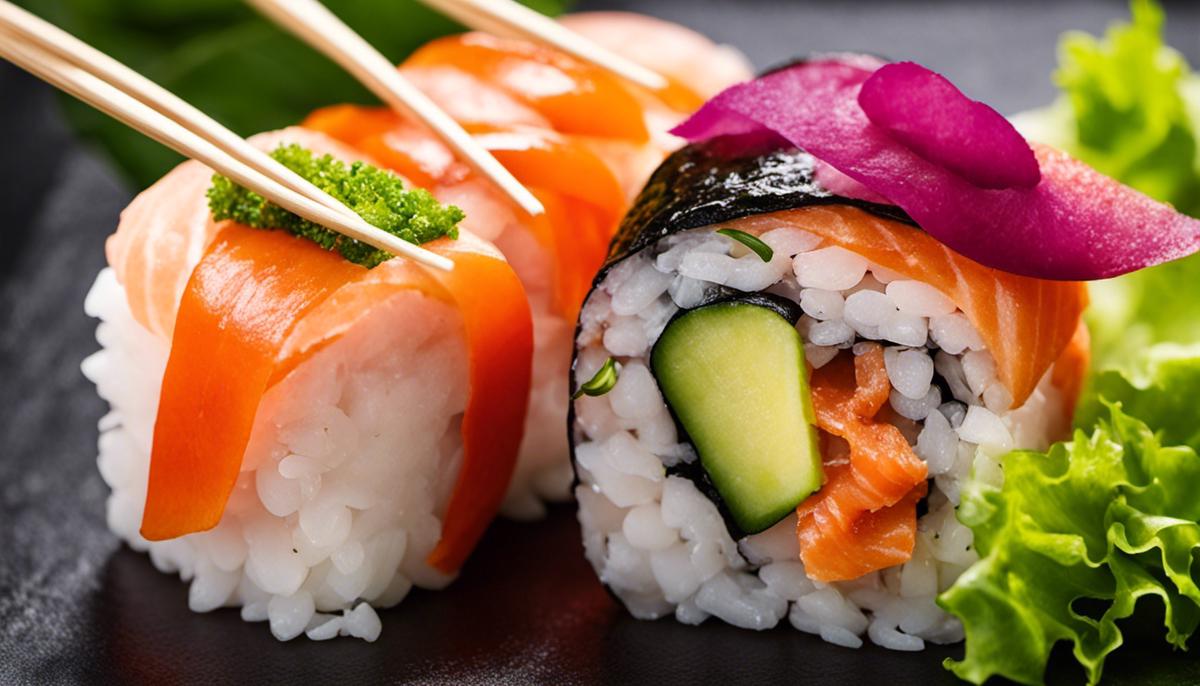
Aesthetics and Presentation of Vegetarian Sushi
The Aesthetics of Vegetarian Sushi
In an artistically ambitious world where eating is more than just food intake, the question arises as to how to present artistic and healthy foods such as vegetarian sushi in an appealing way. How do you create a culinary masterpiece that not only invites you to enjoy it, but is also an eye-catcher?
It’s the performance that counts. The first impression of a dish is made by its presentation, long before the first bite is taken. As we all know, the eye eats with you, and this saying is especially true for sushi. Charming colour contrasts are crucial. Structures of avocado, cucumber, carrots or radishes should be highlighted to add depth and dimension to the dish. The variety of colors and shapes of the ingredients can be fully exploited to create a visually appealing piece of art.
Adapt the serving to the occasion. Vegetarian sushi can be presented in a variety of ways: on a plain stone slab for a rustic ambience or on an elegant porcelain plate for a fine dinner. Rotate each roll slightly differently to create movement on the plate and don’t stack them on top of each other – each sushi roll requires its own space.
Side dishes are not only delicious, but also aesthetically pleasing. The green wasabi paste, sheer rosé-tinted pickled ginger and dark soy sauce create a real contrast to the light sushi rice and colorful fillings. They act not only as flavor enhancers, but also as a natural décor on the sushi plate.
After all, it’s all about the overall concept. From a purely visual point of view, it is much easier to create uniform and clean lines if you arrange everything together. The most beautiful colors and patterns are worth nothing if they are thrown on the plate without regard for harmony and balance. A beautiful arrangement that matches the shape and color of the dishes, glasses and cutlery creates an atmosphere that further stimulates the appetite.
Vegetarian sushi is not only a healthy meal that adapts to current dietary trends, but also a visual delight that is celebrated on the plate. An artful presentation not only increases the appeal of the dish, but also ensures that it is remembered. With the right techniques and tips, each sushi roll becomes a small work of art that pleases the palate and delights the eye.
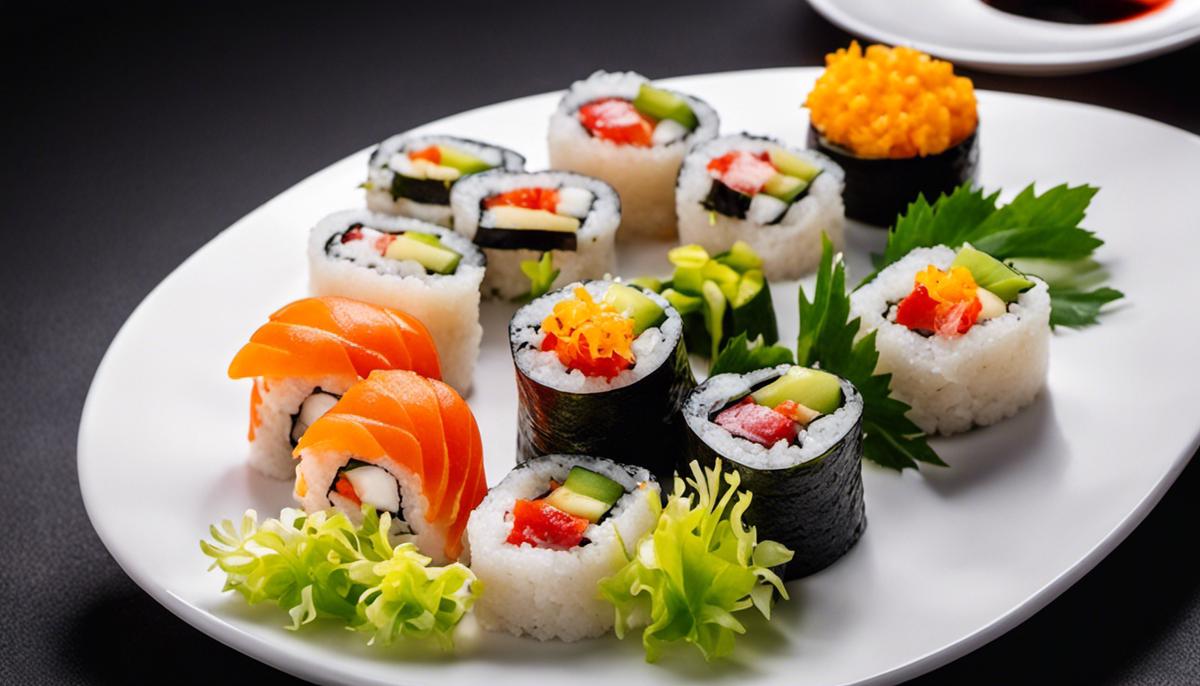
In summary, vegetarian sushi is not only an outstanding addition to a balanced diet, but also a celebrated form of culinary art. Its aesthetics reflect the precision and care that goes into each role. It embodies the best that plant-based cuisine has to offer, both in terms of nutrition and taste. The appeal of preparing vegetarian sushi yourself at home lies in the variety of ingredients used and the endless possibilities of combinations. Give it a try and let yourself be surprised by the discovered flavors while enjoying the health benefits.
